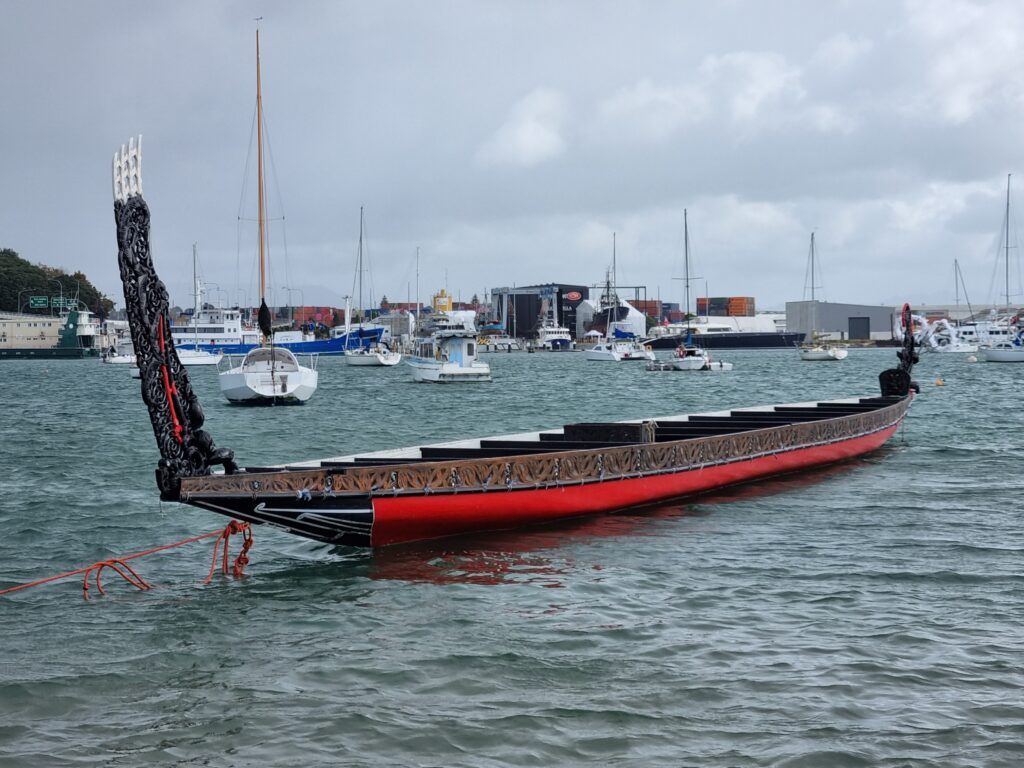
Pūrākau : TĀKITIMU
| Tākitimu was known as a very sacred waka, unlike other waka in the migration Tākitimu was not permitted to carry women and children, nor cooked food. Only specific chiefs were able to be carried on the waka. There were many varied ceremonies performed over by the tohunga to render the Tākitimu seaworthy to travel the great waves of Kiwa, these chiefs and priests were repositories of ancient lore and brought much of the old Hawaiian knowledge taught in the whare wananga to the new land of Aotearoa. In 1350, Tamateaarikinui commanded the Tākitimu. He was accompanied by Tahupōtiki (Ngāi Tahu) and Porourangi (Ngāti Porou), along with his renowned tohunga, Ruawharo, Tupai and Te Rongo Putahi and their adzes Te Awhiorangi (made of greenstone), Te Whironui, Rakuraku-o Tawhaki, Matangireia and Hui-te-rangi-ora. The scaredness of Te Awhiorangi was deemed such that it was not used for material function but reserved only for ceremonial and religious tasks. Six special hoe (paddles) were also crafted for this sacred waka, Rapanga-i-te-ati-nuku, Rapanga-i-te-ati-rangi, Manini-kura, Manini-raro, Tangi-wiwini and Tangi-wawana. During the build of this sacred waka, its craftsmen were also kept under a heavy state of tapu until lifted through ceremonial rites performed by the Tohunga. Once completed, Tākitimu (1) was taken to the great waters of Piko-piko-i-whiti (a historical lagoon to test the seaworthiness of waka), there Ruawharo recited the following karakia: Tu mai awa, tu mai moana Ko koe takahia noatia e au Tupe aunuku, tupe aurangi Whati ki runga, whati ki raro Urumarangaranga Pera hoki ra taku manu na Tane Ka tatau atu ki roto o Nuku-ngaere Maia whiwhia, maia rawea Maia whakatakaia Ka taka te huki rawea Koro i runga, koro i raro Koro i Tawhirimatea ki kora hoki koe tu mai ai Ka hura te Tamatea-nunui Ka hura te Tamatea-roroa Te kauaka nuku, te kauaka rangi Te aio a nuku, te ai a rangi Te kura mai hukihuki Te kawe au tetere Kawea a nuku, kawea a tai Oi! Tumatakokiriritia Hoatu waka ki uta Hoatu waka ki tai Ngaru hinga atu, ngaru hinga mai Kei runga te mata wahine Kei raro te mata tane Huki nawenawe Tenei te waka ka whakairia Ko Tākitimu te waka Ko Tamateaarikinui te tangata Ko Te Awhiorangi te toki Ko Te Rapanga-i-te-ati-nuku te hoe! Guided by their tipua Ruamano and Te Arai-teuru, Tākitimu (1) journeyed the vast waters with the assisted protection from the pakeke (whales) Hine-kotiro, Hine-makehu, and Hine-huruhuru. The kauika (school of Taniwha) that hastened the waka were Te Wehenga kauika, Rua-riki and Maurea. Tākitimu first landed at Te Awanui (on the western end of Ninety Mile Beach), Tamateaarikinui and his crew stayed for a short while and then continued around the North Cape and journeyed down the eastern side of the island. The waka carried on until it made anchorage at Tauranga Moana at the base of Maunganui (Mauao), into the channel Te Awaiti by Te Toka a Tirikawa (North Rock). Below this rock he planted the mauri Uenukurangi, which was a porous rock from Taputapu-Atea. Once this was done, Tamateaarikinui and all his Tohunga made their way to around the base of Maunganui towards Waikorire. They ascended Maunganui towards the ridge, known as the gate to Maunganui. They continued upwards until they reached its summit. There they built two altars called Rehutai and Hikutai these altars were named after the two whatukura (celestial stones) Tamateaarikinui pulled from his topknot, along with the mauri Aukoromoerangi (harakeke from Taputapu-Atea), which he planted it on top of Maunganui. Casting his eyes inland to the South, with his staff, Tamateaarikinui then began to name parts of the region. His eyes were caught by a maunga that reminded him of his homelands, and therefore named it Pūwhenua after the tree that was gifted by Waiataha-a-Hei to build Tākitimu (1). This gifting of the rākau, led to the assurances of marriages between the two iwi, hence the union of Tamatea-pōkaiwhenua and the grand-daughters of Waitaha-a-Hei, Ihuparapara, Iwipupu and Ono-ono-i-waho. After the planting of the Mauri, Aukoromoerangi, Tamateaarikinui set forth to establish a whare wānanga. He made his way inland to a cave that was situated below what is known as Yatton Park. Building 2 pillars and placing a celestial stone on each Tamateaarikunui again began to recite the appropriate Karakia for this task. The whare wānanga was created to focus teachings on celestial knowledge. Tamateaarikinui bestowed the name Tūtarawānanga upon this place of learning. It was and is known to Ngāti Ranginui, as one of the most important sites within Tauranga, secondly only to Mauao. Completing all necessary rituals, Tamateaarikinui settled here, he built his pā at Kawhainui (now known as Mangatawa) and he planted the mauri, Te Pūtiki Wharanui ā Tamatea. Whilst settling in Tauranga, he was given the name Tamatea-Mai-Tawhiti in recognition of this accomplishments. Tamatea, remained in Tauranga until death and was laid to rest in caves facing out to the moana at Te Mangatawa. Tākitimu (1), now under the command of Tahupōtiki, continued down the coast. Along the way the waka arrived at Nukutaurua (present day Mahia peninsula) at a place called Te Papa (near present day Oraka), Ruawharo departed Tākitimu (1) and settled here for a time. Further on as the waka landed in varying bays, it finally reached the Wairarapa. Here Tūpai decided to settle with others from Tākitimu. Tahupōtiki journeyed onwards to Murihiku to the Arahura River on the West Coast, well-known for its abundance of Greenstone. Tākitimu took its last journey in a gorge between forested hills, miles inland. The timber of this sacred waka is said to be petrified to a ledge in the stream. Tamateaurehaea, son to Rongokako and Muriwhenua, was born in Kaitaia and named after his grandfather, Tamateaarikinui. As a descendent of the great Tamateaarikinui, Tamateaurehaea also lusted the nomadic life. His expeditions earned him the names, Tamatea-pōkai-whenua, Tamatea-pōkai-moana. His voyaging spirit lead him to building and commanding his own waka, Tākitimu (2), named after the original Tākitimu(1). |
Waiata
Click here
Waiata – He Pātere mō Tauranga Moana
Waiata – Papaki Tū Ana
Waiata – Tākitimu
Kiriata
Click here
Kiriata – Waka Taua Explained
Other resources :
Nuku Reo :
Click here
